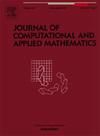在自动重启策略中引入阻尼因子的改进PRP共轭梯度算法
IF 2.6
2区 数学
Q1 MATHEMATICS, APPLIED
Journal of Computational and Applied Mathematics
Pub Date : 2025-03-22
DOI:10.1016/j.cam.2025.116638
引用次数: 0
摘要
本文提出了一种改进的polak - ribi本文章由计算机程序翻译,如有差异,请以英文原文为准。
An improved PRP conjugate gradient algorithm with a damping factor within an automatic restarting strategy
In this paper, we present an improved Polak–Ribière–Polyak (PRP) conjugate gradient algorithm, in which the search direction satisfies the sufficient descent condition with strong Wolfe conditions. A “circuit breaker” mechanism is suggested in the monitoring and pre-warning system concerned with a poor approximation to the scalar β. The resulting instinct self-correcting property is satisfied at each iteration, which can be viewed as the inheritance and development of the original PRP method. Meanwhile, several auxiliary functions are introduced, which achieve twin goals of manipulating the magnitude of conjugate gradient parameter and making swift changes to incorrect predictions if jamming occurs in actual computation. Under mild conditions, we establish the global convergence of the new algorithms and its variants for the general function. Numerical results show our algorithms are practical and effective for the test problems. Finally, the preliminary numerical experiments are given to indicate the efficiency of the proposed methods for image restoration.
求助全文
通过发布文献求助,成功后即可免费获取论文全文。
去求助
来源期刊
CiteScore
5.40
自引率
4.20%
发文量
437
审稿时长
3.0 months
期刊介绍:
The Journal of Computational and Applied Mathematics publishes original papers of high scientific value in all areas of computational and applied mathematics. The main interest of the Journal is in papers that describe and analyze new computational techniques for solving scientific or engineering problems. Also the improved analysis, including the effectiveness and applicability, of existing methods and algorithms is of importance. The computational efficiency (e.g. the convergence, stability, accuracy, ...) should be proved and illustrated by nontrivial numerical examples. Papers describing only variants of existing methods, without adding significant new computational properties are not of interest.
The audience consists of: applied mathematicians, numerical analysts, computational scientists and engineers.

 求助内容:
求助内容: 应助结果提醒方式:
应助结果提醒方式:


